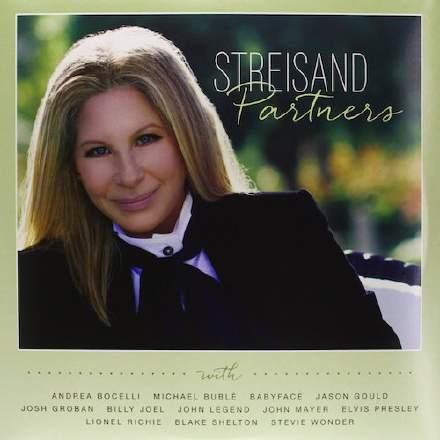
Whatever you think of Barbra Streisand’s music, you’ve got to admire her professional longevity, because she’s apparently topped the Billboard album charts at least once every decade since the ’60s — her latest number one being her 34th studio record, the all-duets album Partners. In the absence of an official single release, I’d like to focus on ‘It Had To Be You’, because it intrigues me how Streisand’s voice relates both to the backing arrangement and to the voice of guest vocalist Michael Bublé.
The first thing that strikes me is how powerful the fundamental frequency of Streisand’s voice often is by comparison with any more characterful timbral energy further up the spectrum. Check out 0:23-0:41 (“making me glad… up to you to explain”), for instance, and in particular the word “blue”, where this bottom-heavy timbre combines with an unnaturally static pitch-centre (need I say more?) to generate a creditable impersonation of a 350Hz test tone! Then, when Bublé’s first phrases zing us with pop-friendly 4kHz and 7kHz spectral peaks, I can’t help feeling that the two voices would have sat together a whole lot better had a couple of decibels been dipped out of his vocal channel at both those frequencies. Not that he has no strong fundamental frequencies, it’s just that they’re rather more sporadic (eg. the big 175Hz peak on “seen” at 2:16) and mostly restricted to those few occasions where he’s singing softly.
Sure, the two vocal tones fit together quite snugly when both leads are singing homophonic harmonies for a couple of phrases from 2:36, but the moment they go their separate ways again at 2:46 they both feel oddly incomplete to me: Streisand’s timbre feels rather bloated, Bublé’s thin and strident. Furthermore, when the horn section starts giving it the full razzle-dazzle at 2:58, Bublé’s vocal tone cuts through fairly easily, but Streisand’s really struggles — her high frequencies are so seriously masked that it sounds like she’s singing through a blanket a lot of the time (on “with all your faults” at 3:27, particularly). Given how loud she is in the mix, the low-mid-range baggage she’s carrying around also makes the rest of the arrangement sound rather gutless by comparison.
For me, this is a textbook case of somewhere I’d have wanted to mult the vocals out to different channels, so that independent EQs could have been applied to Streisand’s voice for the solo and harmony sections, as well as to combat the masking effects of the full-force band texture. Don’t just take my word for it, of course — have a listen for yourself! With a bit of EQ automation, you can even experiment with changing Bublé’s high-mid-range vocal tone by processing the full mix.










